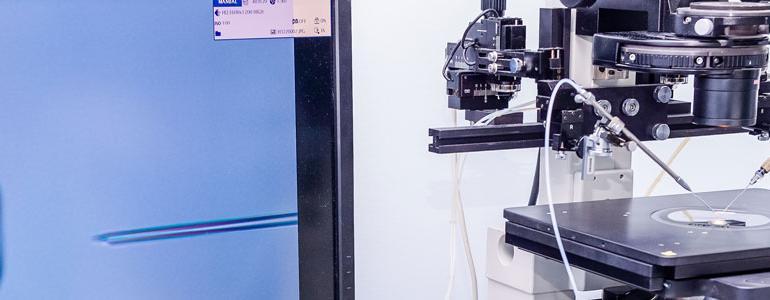Classification of embryos

Every couple undergoing fertility treatment comes across embryological documentation which contains — among other things — information about the grade of an embryo created during an IVF procedure. Robert Szachoń, an embryologist from InviMed, a fertility treatment clinic in Katowice, sheds some light on this difficult, though doubtless relevant, subject.
Fertilized egg, embryo
The Infertility Treatment Act of 2015 defines the embryo as the collection of cells created as a result of the fusion of female and male reproductive cells (the egg and the sperm, respectively). The term ‘embryo’ refers to the stage of development which begins with the fusion of cell nuclei (this process is called karyogamy), and ends with egg implantation in the lining of the uterus.
Embryo incubation and assessment by embryologists is an indispensable part of the IVF procedure. Specialists monitor embryos’ development and morphology very carefully, in order to decide which fertilized eggs may be transferred to uterus.
Where to look for information about embryos?
At InviMed fertility treatment clinics, patients are informed about their embryos’ development by their doctor, who if need be — shows them detailed embryological data. At the end of the cycle they receive the IVF documentation with a summary, which contains embryological data referring to:
- oocyte retrieval (including the division into immature [MI, GV], mature [MII] and degenerative oocytes);
- sperm concentration, motility and volume;
- IVF technique used;
- oocyte fertilization (including information on the oocytes with/without PN pronuclei);
- the number of vitrified oocytes and embryos;
- embryos’ development (numerical data, for instance the number of embryos transferred to the uterus; embryos vitrified; rejected embryos etc.);
- embryo transfer (the date of the transfer; the number of embryos, embryonic age and stage of development);
- assisted fertility techniques and genetic testing.
More detailed medical documentation can be obtained at the clinic, upon request. Because of the need to protect medical data, all the records, including embryological information pertaining to oocytes retrieval, embryo growth, techniques and materials used, can only be collected personally, in the clinic where IVF procedure was performed.
What do the grades of embryos tell us?
Embryo grade estimates the embryo’s potential for further growth, successful implantation in the uterus, and — as a consequence — the chances of childbirth. Embryos are graded on the basis of their external structure (morphology) and the pace of their development (morphodynamics) on a given day. The result of the grading is also a reflection of embryo quality. Low-quality embryos have very little growth — and implantation — potential, so, in order to optimise the chances of achieving IVF success, the embryologists need to choose high-quality embryos for transfer. In fact, IVF success depends largely on embryologists’ knowledge and experience - explains Robert Szachoń, Head of InviMed Laboratory in Katowice.
Embryo classification and assessment
Only mature oocytes — the ones which are at MII stage (the so-called ‘metaphase II oocytes’) — can be used during the IVF procedure. We know that the oocyte has reached the MII stage when the first polar body is present.
If six oocytes were retrieved at the beginning of IVF treatment, and each is at MII stage, they are all fertilized. After fertilization — the process of combining a sperm cell with an ovum — the embryo is incubated and closely monitored by the embryological team. Its development is assessed daily:
Day One: the first assessment takes place 17 hours after sperm cells and egg cells were combined; at this stage we observe the first indicator of the correct or incorrect course of fertilization — the presence of the so-called pronuclei (PN):
- 1 PN
- 2 PN – correctly fertilized ovum on day 1
- 3 PN
- >3 PN
Embryologists also assess the way precursor bodies are placed in the zygote, in order to classify a correctly fertilized 2PN ovum as:
- Grade 1 — symmetrically-placed pronuclei; highest mark;
- Grade 2 — asymmetrically-placed pronuclei and precursor bodies;
- Grade 3 — asymmetrical pronuclei, one or no precursor bodies; lowest mark.
Additionally, after about 26 hours embryologists assess the so-called first division of the cell — if it progresses correctly, the zygote develops into an embryo.
Day Two: assessment of embryo morphology (about 44 hours after fertilization); embryo should be at 4-blastomere (cell) stage.
Day Three: assessment of embryo morphology (about 68 hours after fertilization); embryo should be at 8-blastomere stage.
Embryo grading on days 2-3 also includes the amount of fragmentation:
- Grade 1 — minor fragmentation (less than 10% of embryo volume); highest embryo grade and best prognosis;
- Grade 2 — moderate fragmentation (from 10% to 25% of embryo volume);
- Grade 3 — heavy fragmentation (more than 25% of embryo volume); lowest embryo grade and poor prognosis.
Only grade 1 or 2 embryos which develop at the correct pace can be transferred into the uterus. Grade 3 embryos must not be transferred or vitrified.
Day 4: assessment of embryo morphology 92 hours after fertilization; embryo should be at the morula stage.
Day 5: assessment of embryo morphology circa 116 hours after IVF procedure; embryo should be at the blastocyst stage.
Assessment of the blastocyst stage
On days 5 and 6 embryos should reach the blastocyst stage. Its assessment is more complex and is based on Gardner’s blastocyst grading scale (Gardner and Schoolcraft, 1999).
Days 5 and 6 — assessment of blastocyst development:
Level One: Early Blastocyst
- Level Two: Blastocyst
- Level Three: Expanded Blastocyst
- Level Four: Hatched Blastocyst
Additionally, embryologists assess each of these structures on the basis of two parameters:
- trophoblast (TE) A,B,C — it is responsible for the development of the placenta, and for embryo nutrition;
- the inner cell mass (ICM, embryoblast) A,B,C — it develops into the proper embryo; the embryoblast consists of pluripotent stem cells, which give rise to all body cells.
Embryo transfer takes place on the 3rd, 5th or 6th day of embryo growth, if the patient’s medical condition allows it. Should there be any medical obstacles to the procedure, high-quality embryos are vitrified, and the transfer is performed later, in the frozen IVF cycle. In fact, the latest scientific studies are not in favour of the fresh cycle embryo transfer — meaning the cycle in which oocytes were retrieved and then fertilized — because frozen cycle transfers yield a higher number of pregnancies - says embryologist Robert Szachoń.
Embryological consultation
Couples who have collected their IVF documentation or records pertaining to embryo growth and development, may wish to discuss certain points with their doctor. However, in most cases all the data is perfectly understandable, because it was already explained during earlier visits at the clinic or on the day of the embryo transfer.
At InviMed fertility treatment clinics, all patients are welcome to schedule a free consultation with an embryologist, and discuss the more complex, extended embryological documentation. This is the document which contains, among other things, information about embryo grading.
